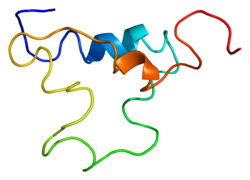
Back عامل النمو شبيه الانسولين-1 Arabic عامل النمو شبيه الانسولين 1 ARZ Insulinoliki faktor rasta 1 BS IGF1 Welsh IGF-1 Danish IGF-1 German Factor de crecimiento insulínico tipo 1 Spanish فاکتور رشد شبهانسولین ۱ Persian IGF-1 French Somatomedina C Galician
Insulin-like growth factor 1 (IGF-1), also called somatomedin C, is a hormone similar in molecular structure to insulin which plays an important role in childhood growth, and has anabolic effects in adults.[5] In the 1950s IGF-1 was called "sulfation factor" because it stimulated sulfation of cartilage in vitro,[6] and in the 1970s due to its effects it was termed "nonsuppressible insulin-like activity" (NSILA).[7]
IGF-1 is a protein that in humans is encoded by the IGF1 gene.[8][9] IGF-1 consists of 70 amino acids in a single chain with three intramolecular disulfide bridges. IGF-1 has a molecular weight of 7,649 daltons.[10] In dogs, an ancient mutation in IGF1 is the primary cause of the toy phenotype.[11]
IGF-1 is produced primarily by the liver. Production is stimulated by growth hormone (GH). Most of IGF-1 is bound to one of 6 binding proteins (IGF-BP). IGFBP-1 is regulated by insulin. IGF-1 is produced throughout life; the highest rates of IGF-1 production occur during the pubertal growth spurt.[12] The lowest levels occur in infancy and old age.[13][14]
Low IGF-1 levels are associated with cardiovascular disease, while high IGF-1 levels are associated with cancer. Mid-range IGF-1 levels are associated with the lowest mortality.
A synthetic analog of IGF-1, mecasermin, is used for the treatment of growth failure in children with severe IGF-1 deficiency.[15] Cyclic glycine-proline (cGP) is a metabolite of hormone insulin-like growth factor-1 (IGF-1). It has a cyclic structure, lipophilic nature, and is enzymatically stable which makes it a more favourable candidate for manipulating the binding-release process between IGF-1 and its binding protein, thereby normalising IGF-1 function.[16]
- ^ a b c GRCh38: Ensembl release 89: ENSG00000017427 – Ensembl, May 2017
- ^ a b c GRCm38: Ensembl release 89: ENSMUSG00000020053 – Ensembl, May 2017
- ^ "Human PubMed Reference:". National Center for Biotechnology Information, U.S. National Library of Medicine.
- ^ "Mouse PubMed Reference:". National Center for Biotechnology Information, U.S. National Library of Medicine.
- ^ Tahimic CG, Wang Y, Bikle DD (2013). "Anabolic effects of IGF-1 signaling on the skeleton". Frontiers in Endocrinology. 4: 6. doi:10.3389/fendo.2013.00006. PMC 3563099. PMID 23382729.
- ^ Salmon WD, Daughaday WH (June 1957). "A hormonally controlled serum factor which stimulates sulfate incorporation by cartilage in vitro". The Journal of Laboratory and Clinical Medicine. 49 (6): 825–836. PMID 13429201.
- ^ Meuli C, Zapf J, Froesch ER (April 1978). "NSILA-carrier protein abolishes the action of nonsuppressible insulin-like activity (NSILA-S) on perfused rat heart". Diabetologia. 14 (4): 255–259. doi:10.1007/BF01219425. PMID 640301.
- ^ Höppener JW, de Pagter-Holthuizen P, Geurts van Kessel AH, Jansen M, Kittur SD, Antonarakis SE, et al. (1985). "The human gene encoding insulin-like growth factor I is located on chromosome 12". Human Genetics. 69 (2): 157–160. doi:10.1007/BF00293288. PMID 2982726. S2CID 5825276.
- ^ Jansen M, van Schaik FM, Ricker AT, Bullock B, Woods DE, Gabbay KH, et al. (1983). "Sequence of cDNA encoding human insulin-like growth factor I precursor". Nature. 306 (5943): 609–611. Bibcode:1983Natur.306..609J. doi:10.1038/306609a0. PMID 6358902. S2CID 4336584.
- ^ Rinderknecht E, Humbel RE (April 1978). "The amino acid sequence of human insulin-like growth factor I and its structural homology with proinsulin". The Journal of Biological Chemistry. 253 (8): 2769–2776. doi:10.1016/S0021-9258(17)40889-1. PMID 632300.
- ^ Callaway E (February 2022). "Big dog, little dog: mutation explains range of canine sizes". Nature. 602 (7895): 18. Bibcode:2022Natur.602...18C. doi:10.1038/d41586-022-00209-0. PMID 35087254. S2CID 246359754.
- ^ Decourtye L, Mire E, Clemessy M, Heurtier V, Ledent T, Robinson IC, et al. (2017). "IGF-1 Induces GHRH Neuronal Axon Elongation during Early Postnatal Life in Mice". PLOS ONE. 12 (1): e0170083. Bibcode:2017PLoSO..1270083D. doi:10.1371/journal.pone.0170083. PMC 5226784. PMID 28076448.
- ^ Suwa S, Katsumata N, Maesaka H, Tokuhiro E, Yokoya S (December 1988). "Serum insulin-like growth factor I (somatomedin-C) level in normal subjects from infancy to adulthood, pituitary dwarfs and normal variant short children". Endocrinologia Japonica. 35 (6): 857–864. doi:10.1507/endocrj1954.35.857. PMID 3250861. S2CID 6965802.
- ^ Landin-Wilhelmsen K, Wilhelmsen L, Lappas G, Rosén T, Lindstedt G, Lundberg PA, et al. (September 1994). "Serum insulin-like growth factor I in a random population sample of men and women: relation to age, sex, smoking habits, coffee consumption and physical activity, blood pressure and concentrations of plasma lipids, fibrinogen, parathyroid hormone and osteocalcin". Clinical Endocrinology. 41 (3): 351–357. doi:10.1111/j.1365-2265.1994.tb02556.x. PMID 7955442. S2CID 24346368.
- ^ Keating GM (2008). "Mecasermin". BioDrugs. 22 (3): 177–188. doi:10.2165/00063030-200822030-00004. PMID 18481900.
- ^ Guan J, Li F, Kang D, Anderson T, Pitcher T, Dalrymple-Alford J, et al. (January 2023). "Cyclic Glycine-Proline (cGP) Normalises Insulin-Like Growth Factor-1 (IGF-1) Function: Clinical Significance in the Ageing Brain and in Age-Related Neurological Conditions". Molecules. 28 (3): 1021. doi:10.3390/molecules28031021. PMC 9919809. PMID 36770687.
© MMXXIII Rich X Search. We shall prevail. All rights reserved. Rich X Search







